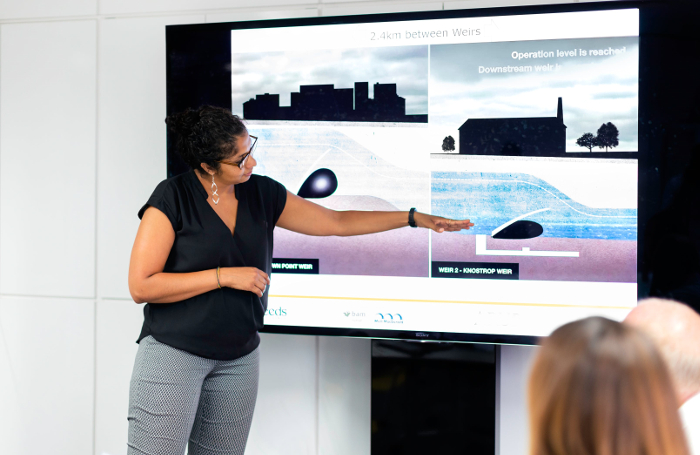“You would be surprised how many people don't actually research the basics about a client,” observes Sadie Morgan, Founding Director of dRMM.
This is a point so fundamental that it might seem like stating the obvious. Any pitch - indeed any presentation at all - will be unsuccessful if you do not understand the background of your audience.
“Do your research. Before any pitch, you have to read up on your client,” Morgan reiterates. “You can only understand where the client is coming from by gathering as much intelligence as you can about who you're pitching to. Then you can tailor your pitch accordingly.”
Next week Sadie Morgan will be speaking at RIBA Future Leaders: Learning to Lead the first of this year’s three Future Leaders events. She will be providing tips on how to land your pitch, making sure it aligns and resonates with the client.
Without conscientiously researching the client you cannot know what is of interest to the different minds around the table or in the video call, Morgan points out.
Pitches should put people first
“It's about people, people, people,” Morgan emphasises. “That should be the starting point in articulating any project.”
“The ability to communicate in a language that is inclusive is really important: with pictures and with words that are universally understood and not intimidating. If you talk to people as if you're in a university you will lose them immediately. When putting together the pitch, ask yourself ‘Am I coming across as approachable?’”
Carlo Magni, Associate at EPR Architects and a member of the RIBA Future Leaders Steering Group, suggests that we should tap into our emotional intelligence when putting a presentation together. We should be thinking about story, about narrative, and how it resonates on a human level.
“What is your overall message?” he asks. “Put yourself in someone else’s position. What do they want to hear?”

Tell a good story, Magni suggests. We are all accustomed to a narrative format: they are a tried and tested medium as old as humanity. Thinking about the formula ‘once upon a time’ can prompt useful ways too.
“Start in an engaging way. You can learn a lot from a trailer on Netflix about your story and how to introduce it. “I will often start with a question; or a quick story that leads into one. A question asks the audience to do something, to consider something. I might ask ‘Have you ever worked on a project that involved X number of Y…?’. It piques their curiosity with something surprising.”
Practice, practice and practice again
You must rehearse, Morgan warns, and recommends at least three practice run-throughs. Timing is very important, and cannot be judged without practice runs. If you have been given 10 minutes to speak, then you must speak for no more than 10 minutes.
“There is nothing worse than overstepping a time limit,” she counsels. “You immediately seem unprofessional: inability to stick to time is a huge minus.”
Timing is also crucial in creating the presentation itself, of course. We all have a tendency to leave things to the last minute, Morgan suggests, and we should always factor in the time for downloading images, rendering an image as a PDF, or printing out any material.
Carlo Magni echoes Morgan’s imperative on proper preparation. He has honed his own presentational skills by practising public speaking at many Toastmasters International meetings. This is a non-profit organisation that teaches public speaking and leadership skills.
“It is a very open and friendly way to improve your public speaking, presentation and communication skills,” Magni enthuses.
“There are very strict timekeepers and you receive very honest, constructive feedback about your content, pace, tone of voice and body language.”
He also points out that we can easily self-assess our practice run-throughs by videoing ourselves.
“Watching yourself present is a powerful learning experience. You can see what your body language is saying, and spot whether you are fidgeting, or moving too much or too little.”
Leave yourself room to manoeuvre
While your pitch should be thoroughly prepared, Sadie Morgan warns that it should not be wholly set in stone.
“You have to be light on your feet; you have to be adaptable,” she urges. “Ideally you should be able to respond to the mood of the moment. You might need to alter your presentation style, or its emphasis, on the spot. This is something that does get easier with experience.”
One tip she suggests is that, in presenting a design idea, do not go for a fully rendered image of a completed building but a sketch: or at least an image that leaves scope for change.
“Show a design idea that does not look as if it’s completely tied down. Give the impression that you are able to shift things; that the design direction will be a conversation.”
Sadie Morgan will be speaking at this year's RIBA Future Leaders 2022: Learning to Lead event on 16 March 2022, the first of the three-part Future Leaders conference. Tickets are now available.
Thanks to Sadie Morgan, Founding Director, dRMM; and Carlo Magni, Associate, EPR Architects.
Text by Matt Milton. This is a Professional Feature edited by the RIBA Practice team. Send us your feedback and ideas.
RIBA Core Curriculum: Business, clients and services.
As part of the flexible RIBA CPD programme, Professional Features count as microlearning. See further information on the updated RIBA CPD Core Curriculum and on fulfilling your CPD requirements as a RIBA Chartered Member.









